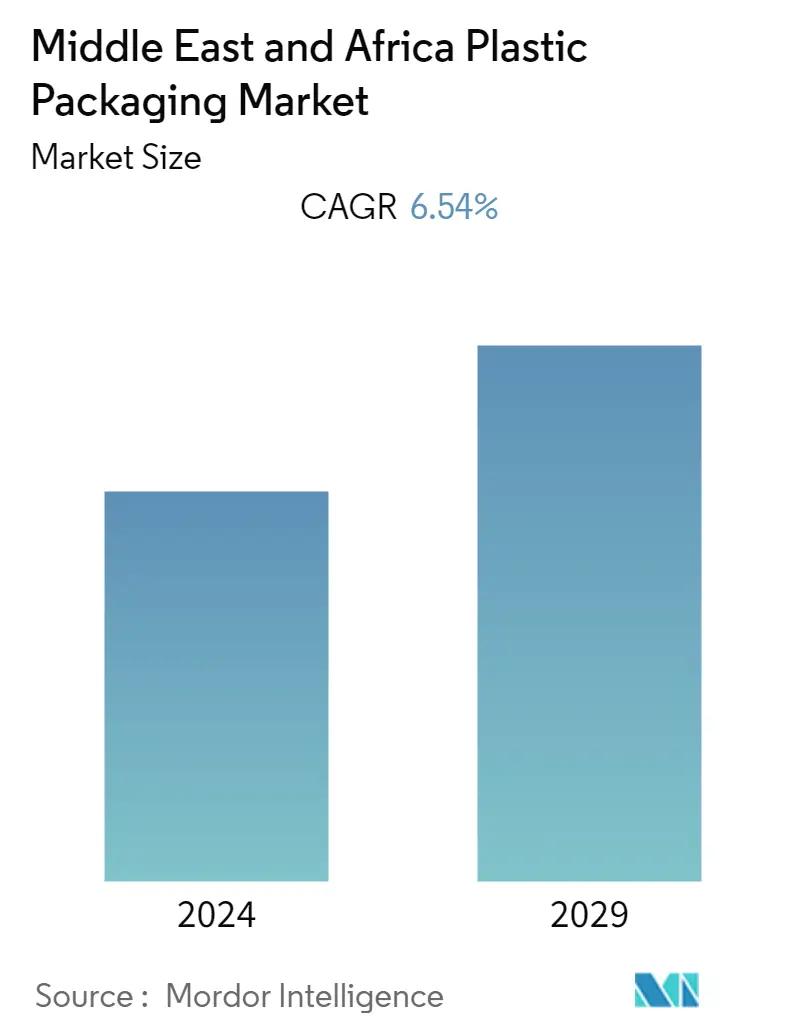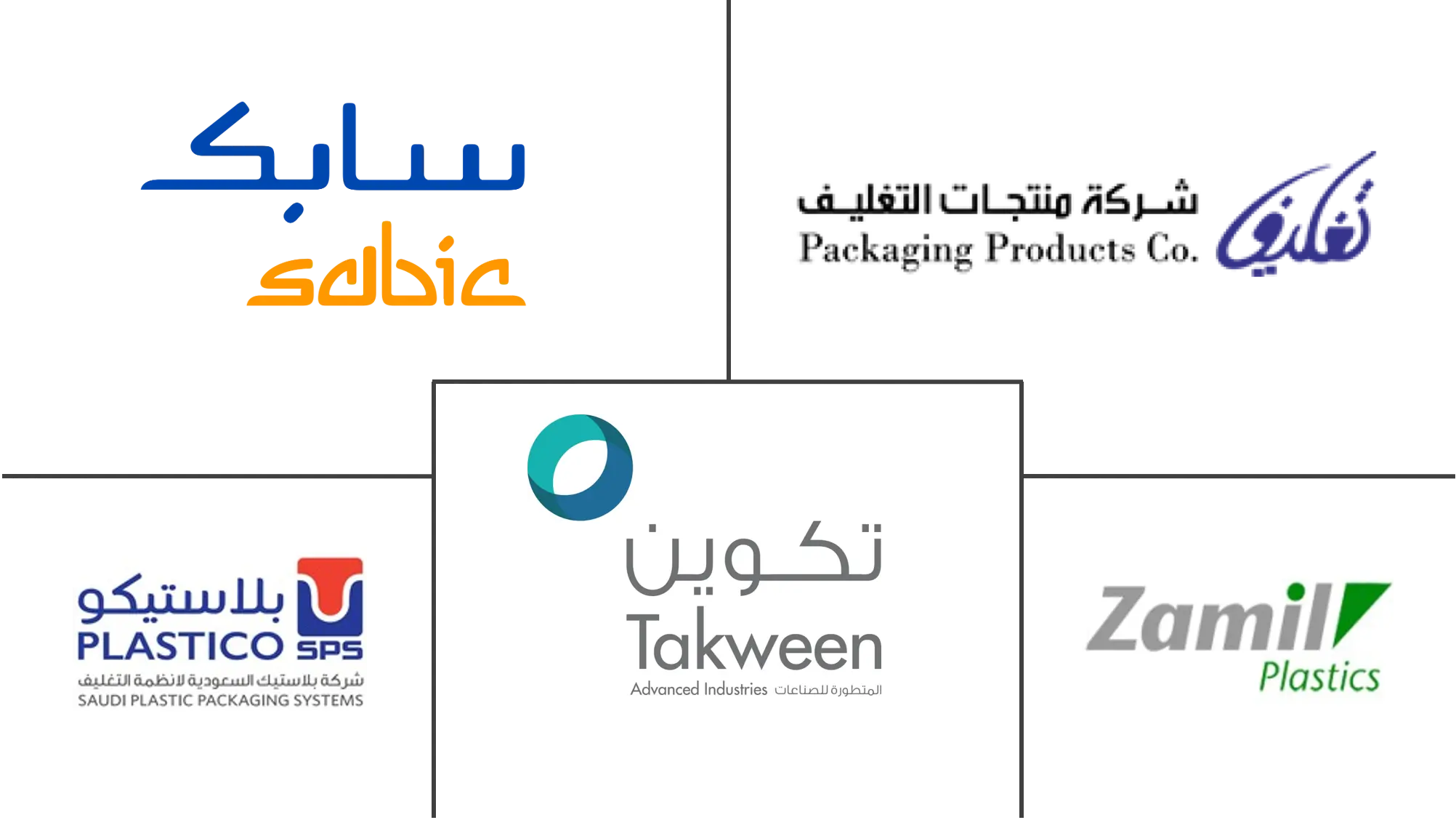Market Size of Middle East and Africa Plastic Packaging Industry

| Study Period | 2019 - 2029 |
| Base Year For Estimation | 2023 |
| Forecast Data Period | 2024 - 2029 |
| Historical Data Period | 2019 - 2022 |
| CAGR | 6.54 % |
| Market Concentration | Low |
Major Players
*Disclaimer: Major Players sorted in no particular order |
MEA Plastic Packaging Market Analysis
The Middle East and Africa plastic packaging market is expected to register a CAGR of 6.54% during the forecast period. With changing consumer trends toward healthier products, regulations, and drive toward sustainability in the MEA region, there is a significant impact on plastic packaging professionals to innovate and evolve materials, designs, and technologies for their customers.
- The beverage industry is the fastest-growing end-user of plastic packaging due to the rising consumption of bottled water and soft drinks. In the latest study published by academics from the UAE and Egypt, although the UAE has stringent municipal water quality standards, bottled water was the source of over 80% of the plain drinking water among participants.
- There is a rising trend of oxo-degradable plastics. Several countries in the Middle East and Africa, including the United Arab Emirates, Saudi Arabia, Yemen, Ivory Coast, South Africa, Ghana, and Togo, are promoting the use of oxo-degradable plastics or have even made their use mandatory.
- The African continent is also expected to become a high-growth region for the plastic packaging industry, with demand being driven by increased markets for consumer products, growing individual incomes, an expanding population of youthful consumers, and booming domestic economies, particularly those in East and West Africa.
- New materials are being developed that are expected to gradually substitute plastic, which might present a challenge for the vendors in the market. Moreover, the growing concern of the user toward the environment and the increase in demand for sustainable packaging solutions, which are made from materials such as paper and other types, can hamper the market's growth.
- Due to the COVID-19 pandemic, consumers in the Middle East drastically ramped up their online purchases of food products. According to Dubai-based Choueiri Group, the main grocery items purchased were products with short shelf life. This was mainly driven by freshness and high nutritional benefits to help boost immunity. The top grocery products for online purchases were dairy products, fruits and vegetables, and bread. The online survey was conducted between mid-March to April, involving 2800 participants.
MEA Plastic Packaging Industry Segmentation
Plastic packaging allows us to protect, preserve, store, and transport products in a variety of ways. The study tracks the demand for plastic packaging in the Middle East and Africa through volume (in million tons) accrued from sales of these plastic packaging products offered by various vendors operating in the region. The market is segmented by packaging type (rigid (by material, by end-user industry) and flexible (by material, by end-user industry)), by products (bottles and jars, tubs, cups, bowls, and trays, intermediate bulk containers, pouches), and by geography (United Arab Emirates, Saudi Arabia, Egypt, South Africa, Rest of Middle East and Africa). The market sizes and forecasts are provided in terms of volume (in million tons) for all the above segments.
| By Packaging Type | ||||||||||||||||
| ||||||||||||||||
|
| By Product | |
| Bottles and Jars | |
| Tubs, Cups, Bowls, and Trays | |
| Intermediate Bulk Containers | |
| Pouches | |
| Other Products |
| By Geography | |
| United Arab Emirates | |
| Saudi Arabia | |
| Egypt | |
| South Africa | |
| Rest of Middle East and Africa |
Middle East and Africa Plastic Packaging Market Size Summary
The Middle East and Africa plastic packaging market is poised for significant growth, driven by evolving consumer preferences, regulatory changes, and a strong push towards sustainability. The beverage sector, particularly bottled water and soft drinks, is a major contributor to this growth. The region is witnessing a shift towards oxo-degradable plastics, with several countries mandating their use. The African continent, with its expanding consumer base and burgeoning economies, is emerging as a high-growth area for plastic packaging. However, the market faces challenges from the development of alternative materials and increasing demand for sustainable packaging solutions. The COVID-19 pandemic has also influenced consumer behavior, with a surge in online grocery purchases, further impacting packaging demands.
Saudi Arabia stands out as a key player in the region's plastic packaging industry, with a robust consumer base and diverse industrial activities fueling demand. The country's initiatives to strengthen its non-oil sector, such as Vision 2030, are expected to boost industrial production, including plastic packaging. The demand for flexible packaging is on the rise, driven by the need for high-end packaging solutions and the expansion of the consumer sector. The market is competitive, with major players like SABIC and Zamil Plastic Industries Co. adopting strategies like product innovation and partnerships to maintain their market position. Recent developments, such as Comexi's establishment of a showroom in the Middle East and SABIC's collaboration with international brands for recycling initiatives, highlight the dynamic nature of the market.
Middle East and Africa Plastic Packaging Market Size - Table of Contents
-
1. MARKET DYNAMICS
-
1.1 Market Overview
-
1.2 Market Drivers
-
1.2.1 Demand for Oxo-Degradable Plastics
-
-
1.3 Market Challenges
-
1.3.1 Environmental Concerns over Recycling and Safe Disposal
-
-
1.4 Industry Value Chain Analysis
-
1.5 Porter's Five Forces Analysis
-
1.5.1 Threat of New Entrants
-
1.5.2 Bargaining Power of Buyers
-
1.5.3 Bargaining Power of Suppliers
-
1.5.4 Threat of Substitute Products
-
1.5.5 Intensity of Competitive Rivalry
-
-
1.6 Impact of COVID-19 on the Market
-
1.7 Current Trade Dynamics (Import/Export Analysis)
-
1.8 Regulatory Environment across Countries
-
-
2. MARKET SEGMENTATION
-
2.1 By Packaging Type
-
2.1.1 Rigid
-
2.1.1.1 By Material
-
2.1.1.1.1 Polyethylene (PE)
-
2.1.1.1.2 Polyethylene Terephthalate (PET)
-
2.1.1.1.3 Polypropylene (PP)
-
2.1.1.1.4 Polystyrene (PS) and Expanded Polystyrene (EPS)
-
2.1.1.1.5 Polyvinyl Chloride (PVC)
-
-
2.1.1.2 By End-user Industry
-
2.1.1.2.1 Food
-
2.1.1.2.2 Beverage
-
2.1.1.2.3 Healthcare and Pharmaceutical
-
2.1.1.2.4 Cosmetics and Personal Care
-
2.1.1.2.5 Other End-user Industries
-
-
-
2.1.2 Flexible
-
2.1.2.1 By Material
-
2.1.2.1.1 Polyethene (PE)
-
2.1.2.1.2 Bi-orientated Polypropylene (BOPP)
-
2.1.2.1.3 Cast Polypropylene (CPP)
-
2.1.2.1.4 Polyvinyl Chloride (PVC)
-
2.1.2.1.5 Other Flexible Plastic Packaging Materials
-
-
2.1.2.2 By End-user Industry
-
2.1.2.2.1 Food
-
2.1.2.2.2 Beverage
-
2.1.2.2.3 Cosmetics and Personal Care
-
2.1.2.2.4 Other End-user Industries
-
-
-
-
2.2 By Product
-
2.2.1 Bottles and Jars
-
2.2.2 Tubs, Cups, Bowls, and Trays
-
2.2.3 Intermediate Bulk Containers
-
2.2.4 Pouches
-
2.2.5 Other Products
-
-
2.3 By Geography
-
2.3.1 United Arab Emirates
-
2.3.2 Saudi Arabia
-
2.3.3 Egypt
-
2.3.4 South Africa
-
2.3.5 Rest of Middle East and Africa
-
-
Middle East and Africa Plastic Packaging Market Size FAQs
What is the current Middle East and Africa Plastic Packaging Market size?
The Middle East and Africa Plastic Packaging Market is projected to register a CAGR of 6.54% during the forecast period (2024-2029)
Who are the key players in Middle East and Africa Plastic Packaging Market?
SABIC - Saudi Basic Industries Corporation, Zamil Plastic Industries Co., Takween Advanced Industries , Packaging Products Company (PPC) and Plastico SPS are the major companies operating in the Middle East and Africa Plastic Packaging Market.

